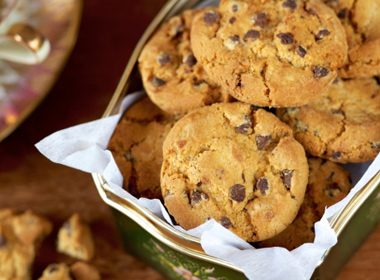Make Your Baked Goods Last
Nothing says home like home-baked goodies. Here’s how to keep those cakes, pies, and cookies fresh until the last morsel is gobbled up.

Cool Cakes Before Storing
Many unfrosted cakes will keep well on your countertop for up to a week if wrapped in plastic wrap, kept under a cake dome, or if the cake is covered in foil. The key is to cool the cake completely before wrapping. Doing it before the cake is cool encourages mold growth in the pockets of moisture. Set the cake in the pan on a wire rack to cool until you can touch it without hurting your fingers. Then remove the cake from the pan, and continue cooling on the rack. Finally, set it on a cake dish. Keep the wrapped or domed cake in an area free from moisture and humidity.
Whip Topping at the Last Minute
Whipped-cream frosting doesn’t hold up more than a day or two in the fridge. It becomes “weepy” and loses its consistency. So if you need to make the cake in advance, don’t whip up the topping until just before you serve it. You might even serve up the whipped cream in a nice bowl and let your guests dollop on their own frosting.
Frosting Facts
If a cake frosting is made with eggs, custard, whipped cream, or cream cheese, you’ll have to refrigerate the cake. You can take it from the refrigerator and bring it to room temperature prior to cutting the first time you serve, of course. Chilling the cake may lessen the flavours, so you’ll want to remove it from the refrigerator again before serving seconds. Some frostings are safe to keep out of the fridge. Cakes frosted with store-bought, canned frostings are usually fine for about five days on your counter if properly covered under a dome or a loose-fitting helmet of foil.
What’s Inside Counts
Cakes with fruit filling or topping, cakes with perishable ingredients, and cheesecakes must be refrigerated. Triple-wrap cakes to retain that just-baked freshness, you can freeze unfrosted cakes for several months if you triple-wrap them first. Once it has cooled, wrap each layer of the cake in plastic, then foil. Next pop the layers into a freezer bag and squeeze out the excess air. When defrosting, let the cake come to room temperature before rewrapping. If you don’t have a cake-keeper or glass dome, it’s easy to improvise one. Just put a large bowl upside down over the cake to protect it.
Give Your Pies an Encore
Baking two pies isn’t much more trouble than baking one. So when baking a pie for dinner tonight, do yourself a favour and double the recipe. Once you’ve baked and cooled both pies, wrap the extra one in plastic and foil, and pop it into a freezer bag for later use.
Cookie Climate
When storing crisp cookies, the humidity of the climate you live in makes a big difference. If you live in a dry climate, store the cookies in a container or jar with a loose-fitting lid; if you live in a humid climate, cover them tightly.
Keep Cream Cheese and Custard Cookies Cool
Always refrigerate cookies that are made with cream cheese or that have with a custard filling or frosting. If you just cover them loosely with aluminum foil, they should keep for the better part of a week.
Freezing is Fine
You can store fully baked and cooled cookies in the freezer for several months if you put them in a sealed, airtight container. Unfortunately, freezing is not recommended for cookies with low butterfat content, because they tend to dry out.
Keep Your Cookie Dough
Tightly wrap your homemade cookie dough in plastic, and it will last for up to three or four days in the fridge before it begins to loose its consistency. Need to store it longer? Pop the wrapped dough in the freezer, and it will last for at least a month before the flavour fades and consistency breaks down.



